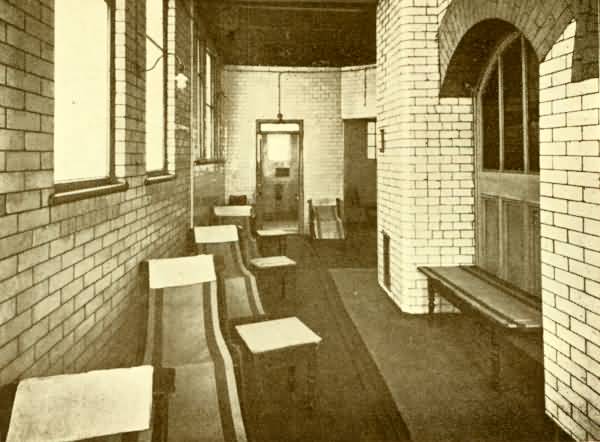Victorian Turkish Baths Picture of the Month for October 2010
Kenworthy's Hydropathic Establishment, Southport:
men's hot room
[or, more probably, cooling room],
c.1920

Kenworthy's was one of at least three large nineteenth century hydropathic establishments to be found in Southport. It was originally opened by Samuel Kenworthy in 1876 as The Limes Hydropathic Establishment,1 but does not seem to have changed its name officially to Kenworthy's until Samuel's son took over in 1899.
In 1890 Kenworthy's had two suites of Turkish, Russian, Electro-Chemical and Hydropathic Baths, one for men and the other for women.
Although the caption in the prospectus clearly indicates that the photograph is of the men's hot room, this seems unlikely. First, a long narrow rectangular area—which in the image looks to be at least thirty foot long by a bare seven foot at its narrowest—is a very unusual shape for a hot room, especially if it was the hottest; it would have been too long to be heated uniformly. Second, it would have been very unusual to include tables in the hot room; there is no need for them. It seems more likely that the room seen through the diagonally placed opening in the background is a hot room.
The provision of recliners and tables strongly suggests that this was the cooling room. And if the arrangement of the recliners seems rather forbidding—one normally associates cooling rooms with relaxation and conversation—it should be borne in mind that these rooms were in a traditional hydropathic establishment where the whole Turkish bath process was thought of as part of a cure. Bathers would be discouraged from conversing during any part of it.
Patients were charged from two guineas per week including accommodation, meals, and any baths prescribed by the house physician.2
By the early 1920s, a week's stay cost from £3 13 6 to £5 19 6 per person. Different rates applied, of course, for nurses, chauffeurs, and attendants, with even lower rates being charged for servants or maids. Visitors and out-patients were charged 2/6d for a Turkish and Russian bath, massage and shampoo, with a series of six baths being charged at the price of five.3

Victorian Turkish Baths: their origin, development, and gradual decline



Comments and queries are most welcome and can be sent to:
malcolm@victorianturkishbath.org
The right of Malcolm Shifrin to be identified as the author of this work
has been asserted by him
in accordance with the Copyright, Designs and Patents Act 1988
© Malcolm Shifrin, 1991-2023